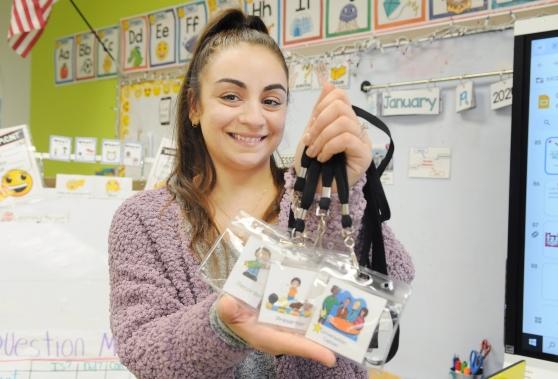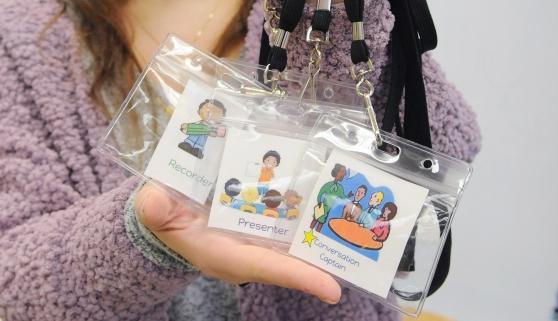
Gabriella Ramaglia uses lanyards to help her students remember their roles and responsibilities in small-group discussions.
The Department of Education has recently encouraged special education and integrated co-teaching teachers to prioritize targeted small-group instruction, including station teaching. That shift has meant that I’ve had to learn new classroom management and pedagogical strategies for my 12:1:1 special education class for 3rd- and 4th-graders.
Small-group work and station teaching can be noisy and chaotic. Even with two educators circulating in the room, there will still be groups or a station where students are expected to work collaboratively or independently without an adult at the table. In these situations, some students will goof off, some will dominate the discussion and other students will be too shy to contribute at all.
I’ve had to experiment with teaching methods that turn this inevitable chaos into organized, productive chaos.
My first priority is to ensure that every student has an opportunity to meaningfully contribute to the overall learning task. To do this, I introduced five collaborative roles in my classroom: conversation captain, encourager, participant, recorder and presenter. In each group, every student is assigned a role and dons a lanyard with an illustration of their role and their title. The students are expected to assume the responsibilities that go along with the title.
The conversation captain is the student who starts the discussion for their group. The student may read the task directions, the text or math problem. This student also facilitates the discussion by asking questions throughout the work time together.
The encourager provides feedback to the group members throughout the process. Feedback is given based on the success criteria of the task (which I go over before we start the day’s group work). For example, the encourager might say, “I love that you are referring to the text to show your research.”

Lanyards remind students of their roles and tasks in small group discussions.
The participant makes sure that every student in the group has an opportunity to speak.
The recorder takes the lead in recording the group’s activities, such as making note of the steps to solve a math problem or writing notes in a note-taking graphic organizer. The recorder also ensures that the other students in the group are also recording information in their personal notebooks.
Finally, the presenter leads the presentation of work to the rest of the class, but all students in the group stand alongside the presenter and are expected to contribute.
It does take time to instruct students in the responsibilities of each role and for students to use them in a meaningful way. I start by modeling one role each week, giving students lots of time to practice each role.
Collaborative roles ensure that every student is participating and accountable to their partners during group work. Of course, some days can be challenging, and some students need significant teacher support with their roles — and that is OK.
Overall, I’ve seen a boost in my students’ engagement and confidence as they rotate through the roles. My students are now eager to participate in group work, student discussions are more animated, and the students retain more information. These collaborative roles have made small group work more productive and meaningful — both for my students and for me.
Gabriella Ramaglia, a 2023 Big Apple Award winner, is a special education teacher at PS 306 in Woodhaven, Queens.